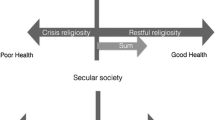Abstract
A manda is a religious quid pro quo whereby an older Mexican American promises to perform a religious act if the Virgin or one of the saints grants a request. The purpose of this study is to see whether making mandas is associated with health among older Mexican Americans. Findings from the study model suggest that making mandas is associated with a greater sense of personal control, and more personal control is associated, in turn, with better health.

Similar content being viewed by others
References
Barna, G. (2002). The state of the church 2002. Ventura, CA: Issachar Resources.
Berger, P. L. (1967). The sacred canopy: Elements of a sociological theory. New York: Doubleday.
Carstensen, L. L. (1992). Social and emotional patterns in adulthood: Support for socioemotional selectivity theory. Psychology and Aging, 7, 331–338.
Chandra, A., & Skinner, J. S. (2004). Geography and racial health disparities. In N. B. Anderson, R. A. Bulatao, & B. Cohen (Eds.), Critical perspectives on racial and ethnic differences in health in late life (pp. 604–639). Washington, DC: The National Academic Press.
DeShon, R. P. (1998). A cautionary note on measurement error correlations in structural equation models. Psychological Methods, 3, 412–423.
du Toit, M., & du Toit, S. (2001). Interactive LISREL: User’s guide. Lincolnwood, IL: Scientific Software International.
Enders, C. K. (2001). A primer on maximum likelihood algorithms available for use with missing data. Structural Equation Models, 8, 128–141.
Fernandez, E. C. (2007). Mexican American catholics. New York: Paulist Press.
Hill, P. C., & Hood, R. W. (1999). Measures of religiosity. Birmingham, AL: Religious Education Press.
Hill, T. D., Angel, J. L., Ellison, C. G., & Angel, R. J. (2005). Religious attendance and mortality: An 8-year follow-up of older Mexican Americans. Journal of Gerontology: Social Sciences, 60B, S102–S109.
Hummer, R. A., Benjamins, M. R., & Rogers, R. G. (2004). Racial and ethnic disparities in health and mortality among the US elderly population. In N. B. Anderson, R. A. Bulatao, & B. Cohen (Eds.), Critical perspectives on racial and ethnic differences in health in late life (pp. 53–94). Washington, DC: The National Academic Press.
Janz, N. K., Champion, V. L., & Strecher, V. J. (2002). The Health Belief Model. In K. Glanz, B. K. Rimer, & F. M. Lewis (Eds.), Health behavior and health education: Theory, research, and practice (pp. 45–66). San Francisco: Jossey-Bass.
Kelloway, E. K. (1998). Using LISREL for structural equation modeling. Thousand Oaks, CA: Sage.
Kline, R. B. (2005). Principles and practice of structural equation modeling. New York: Guilford.
Krause, N. (2003). The social foundations of personal control in late life. In S. H. Zarit, L. I. Pearlin, & K. W. Schaie (Eds.), Personal control in social and life course contexts (pp. 45–70). New York: Springer.
Krause, N. (2004). Common facets of religion, unique facets of religion, and life satisfaction among older African Americans. Journal of Gerontology: Social sciences, 59B, S287–S297.
Krause, N., & Bastida, E. (2009). Religion, suffering, and health among older Mexican Americans. Journal of Aging Studies, 23, 114–123.
Levin, J. S., & Markides, K. S. (1985). Religion and health in Mexican Americans. Journal of Religion and Health, 24, 60–69.
Markides, K. S. (2003). Hispanic established populations for the epidemiologic studies of the elderly 1993–1994. study number 2851. Ann Arbor, MI: Inter-university Consortium for Political and Social Research.
Mirowsky, J. (1995). Age and sense of control. Social Psychology Quarterly, 58, 31–43.
Mirowsky, J., & Ross, C. E. (1984). Mexican culture and emotional contradictions. Journal of Health and Social Behavior, 25, 2–13.
National Center for Health Statistics. (2008). Health, United States, 2008. Washington, DC: US Government Printing Office.
Newman, D. A. (2003). Longitudinal modeling with randomly and systematically missing data: A simulation of ad hoc, maximum likelihood, and multiple imputation techniques. Organizational Research Methods, 6, 328–362.
Nouwen, H. (2009). The essential Henri Nouwen. Boston: Shambhala. (edited by R. A. Jonas).
Pearlin, L. I., Menaghan, E., Lieberman, M., & Mullan, J. (1981). The stress process. Journal of Health and Social Behavior, 22, 337–356.
Rodriquez, J. (1994). Our Lady of Guadalupe: Faith and empowerment among Mexican-American women. Austin, TX: University of Texas Press.
Rotter, J. B. (1966). Generalized expectations for internal versus external control of reinforcement. Psychological Monograph, 80, 1–28.
Schieman, S., Pudrovska, T., Pearlin, L. I., & Ellison, C. G. (2006). The sense of divine control and psychological distress: Variations across race and socioeconomic status. Journal for the Scientific Study of Religion, 45, 529–549.
Segall, M. H., Lonner, W. J., & Berry, J. W. (1998). Cross-cultural psychology as a scholarly discipline: On the flowering of culture in behavioral research. American Psychologist, 53, 1101–1110.
Simpson, J. A. (2007). Foundations of interpersonal trust. In A. W. Kruglanski & E. T. Higgins (Eds.), Social psychology: A handbook of basic principles (pp. 587–607). New York: Guilford.
Taylor, R. J., Chatters, L. M., & Levin, J. (2004). Religion in the lives of African Americans: Social, psychological, and health perspectives. Thousand Oaks, CA: Sage.
United States Bureau of the Census. (2010). 2006–2008 American community survey 3-year estimates: Data highlights. Available on the following website: http://factfinder.census.gov/servlet/ACSSAFFacts.
Acknowledgments
This research is supported by a grant from the National Institute on Aging (RO1 AG026259) and a grant from the John Templeton Foundation that was administered through the Center for Spirituality, Theology, and Health at Duke University.
Author information
Authors and Affiliations
Corresponding author
Rights and permissions
About this article
Cite this article
Krause, N., Bastida, E. Religion and Health Among Older Mexican Americans: Exploring the Influence of Making Mandas. J Relig Health 51, 812–824 (2012). https://doi.org/10.1007/s10943-010-9389-9
Published:
Issue Date:
DOI: https://doi.org/10.1007/s10943-010-9389-9




